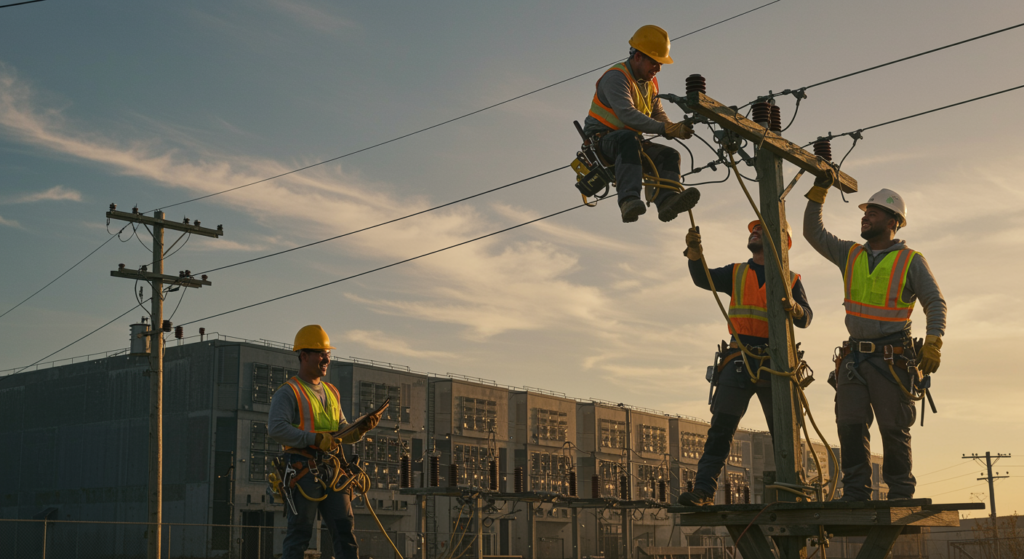
AI Power Crunch: Google Funds Electrician Training to Boost AI Energy Needs
Google Tackles AI’s Growing Power Demands with Massive Electrician Training Initiative
Google’s electrician training program is stepping up to the plate as AI reshapes our world, demanding more power than ever. On April 30, 2025, the tech giant announced a major investment to train 100,000 electrical workers and 30,000 apprentices across the U.S., directly addressing the surge in energy needs from AI data centers. This effort, backed by a $10 million grant, aims to build a stronger workforce and ease the strain on our power grid—what a smart move for sustainable growth.
You might wonder, why focus on training electricians right now? It’s because AI’s rapid expansion is fueling an energy crisis, and Google’s electrician training is designed to fill that gap by preparing skilled professionals for the front lines. Through partnerships like the electrical training ALLIANCE, formed by the National Electrical Contractors Association and the International Brotherhood of Electricians, this initiative could expand the workforce pipeline by about 70% in five years. As outlined in Google’s own announcement, this isn’t just about fixing today’s problems—it’s about powering tomorrow’s innovations.
The AI Energy Crisis: Understanding the Challenge
The heart of this issue lies in how AI is transforming energy consumption, making Google’s electrician training a timely solution to the AI power crunch. Data centers, the backbone of AI operations, gobble up enormous amounts of electricity, and projections show they could add 15-90 GW to U.S. demands by 2030. That’s like powering millions of homes, highlighting why initiatives like Google’s electrician training are essential for keeping up.
Think about it: even with advancements in energy-efficient tech, we can’t rely on that alone to handle the load. Google’s recent white paper, “Powering a New Era of American Innovation,” breaks it down clearly, stressing the need for a robust electrical workforce to support this growth. What if we didn’t act? Shortfalls could slow down economic progress, which is why Google’s electrician training feels like a game-changer.
The Growing Electrician Shortage
Amid all this, there’s a glaring shortage of electricians, and Google’s electrician training is directly combating it. Estimates from McKinsey suggest we need an extra 130,000 electricians by 2030 just for data centers and manufacturing. With about 10,000 electricians retiring or leaving the field each year and only 7,000 new ones entering, the imbalance is real and urgent.
That’s where leaders like Kenneth Cooper from the IBEW see hope—programs like Google’s could bring in over 100,000 new electricians to handle AI’s power demands. Imagine the ripple effect: not just more jobs, but a stronger economy fueled by AI. If you’re in the trades or considering it, this might be your cue to get involved.
Google’s Comprehensive Approach to the Power Challenge
Google isn’t stopping at just training; their strategy weaves in policy and innovation to tackle the AI power crunch head-on. The white paper outlines 15 key opportunities, focusing on advanced energy tech, grid optimization, and yes, expanding the workforce through Google’s electrician training. It’s a holistic plan that recognizes every piece matters.
From investing in nuclear power to streamlining transmission, Google’s approach ensures we have the infrastructure for AI’s future. But let’s not overlook the human element—training programs are vital, making Google’s electrician training a cornerstone of this effort. How can we make this work? By blending tech with skilled labor, we create a more resilient system.
AI Integration in Electrical Training
Here’s where it gets interesting: Google’s electrician training isn’t just about basic skills; it’s incorporating AI tools right into the curriculum. The electrical training ALLIANCE is using AI to enhance teaching methods and ramp up apprenticeships, giving workers access to Google’s AI Essentials course. This prepares them for a world where AI and electrical work go hand in hand.
It’s a clever full-circle moment—AI driving the need for more electricians, and now fueling their training. If you’re eyeing a career in this field, ask yourself: how can AI make you more effective on the job? Programs like this could be the key to staying ahead.
The Economic Opportunity Behind the Energy Challenge
At its core, Google’s electrician training links directly to economic growth, turning the AI power crunch into a chance for prosperity. The white paper points out a clear tie between energy use and innovation, with AI poised to boost the U.S. economy through new jobs and scientific breakthroughs. By investing in electrical workers, Google is helping unlock this potential.
Just picture it: a surge in data centers creating thousands of roles, from engineers to electricians. Google’s initiative ensures we’re ready, blending energy expansion with workforce development. What opportunities might this open for you or your community?
A Broader Pattern of Tech Industry Energy Investments
Google’s electrician training fits into a larger trend where tech giants are pouring resources into solving power issues. With AI accelerating electricity demand after years of stability, companies are racing to avoid bottlenecks, much like Google’s efforts. President Trump’s national energy emergency declaration underscores how critical this is, pushing for faster project approvals.
This isn’t isolated; it’s a collective push, with Google’s training program as a standout example. If tech and energy sectors can collaborate like this, we might just outpace the AI power crunch. Have you noticed similar investments in your area?
Public-Private Collaboration
Google emphasizes that no one entity can fix this alone, calling for teamwork between governments and companies. Through initiatives like Google’s electrician training, we’re seeing how shared efforts can build a skilled workforce model. It’s about creating pathways for the next generation, blending public support with private innovation.
Why does this matter? Because collaborative programs can scale quickly, addressing shortages while fostering economic gains. If you’re in policy or business, consider how you might join forces on something similar.
Google’s Broader AI Training Initiatives
Beyond electricians, Google’s commitment to AI skills is wide-reaching, with programs like the AI Opportunity Fund aiming to equip 1 million Americans. This ties back to Google’s electrician training, ensuring both tech-savvy and trade skills thrive in an AI world. For instance, a recent $1 million grant to a South Carolina nonprofit highlights this focus on community-level training.
It’s a reminder that AI’s future needs diverse talent, from coders to craftsmen. Could this inspire you to pursue AI-related skills in your own career?
The Road Ahead: Challenges and Opportunities
While Google’s electrician training is a strong start, challenges like scaling up infrastructure remain. It will take time to train enough workers to fully meet AI’s power demands, but the potential rewards are huge. From new career paths to economic boosts, this initiative could spark real change.
Opportunities include better job prospects in skilled trades, support for growing industries, and faster energy tech advancements. What’s one way you could benefit from programs like this?
Timeline and Implementation
Looking ahead, Google’s electrician training aims for a 70% workforce increase in five years, focusing on apprenticeships and AI-enhanced learning. Organizations like the IBEW and NECA will play key roles, making this a structured rollout. Keep an eye on how these efforts evolve—they could set a standard for other sectors.
If you’re interested in joining, check for local programs and see how Google’s support might help. It’s about building a future where AI and energy work seamlessly together.
Conclusion: Powering the Future of AI
In wrapping up, Google’s electrician training stands as a vital response to the AI power crunch, blending human expertise with technological needs. By investing in workers and infrastructure, it’s paving the way for sustainable AI growth. Remember, even the most advanced AI relies on real-world support to succeed.
As this program unfolds, it could inspire similar solutions across industries. What are your thoughts on how we can keep innovating while managing energy demands? Share your ideas in the comments, explore more on our site, or pass this along to someone in the field—let’s keep the conversation going!
References
- Engadget. “Google is funding electrician training to help meet the power demands of AI.” Link
- Google Blog. “Electrical workers and AI training.” Link
- Slashdot. “Google funding electrician training as AI power crunch intensifies.” Link
- AI Topics. News article. Link
- Google Startups. “AI for Energy Accelerator.” Link
- YouTube. Video source. Link
- ABC News 4. “Google.org awards $1M for AI training in South Carolina.” Link
Google electrician training, AI power demands, electrical workforce shortage, data center energy needs, Google.org funding, AI energy crisis, electrician apprenticeship programs, sustainable AI infrastructure, tech industry investments, skilled trades in AI era







